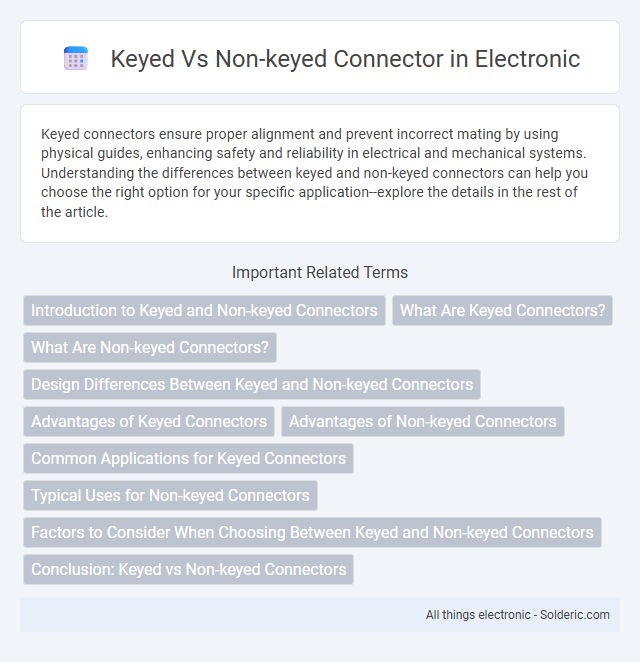Keyed connectors ensure proper alignment and prevent incorrect mating by using physical guides, enhancing safety and reliability in electrical and mechanical systems. Understanding the differences between keyed and non-keyed connectors can help you choose the right option for your specific application--explore the details in the rest of the article.
Comparison Table
| Feature | Keyed Connector | Non-Keyed Connector |
|---|---|---|
| Definition | Connector with a specific alignment key or slot ensuring precise mating | Connector without a key; relies on general fit and orientation |
| Alignment | Guaranteed correct alignment due to keying | Potential risk of misalignment during mating |
| Prevent Incorrect Mating | Yes, key prevents wrong connection | No, easy to connect incorrectly |
| Use Case | Critical connections needing error-free assembly | Simple connections with low risk of damage |
| Cost | Generally higher due to added complexity | Lower manufacturing cost |
| Durability | Enhanced due to proper fit and prevention of damage | Possible wear from incorrect mating attempts |
Introduction to Keyed and Non-keyed Connectors
Keyed connectors feature unique shapes or physical guides that ensure proper alignment and prevent incorrect mating, enhancing reliability in electrical and mechanical connections. Non-keyed connectors lack these guiding elements, offering flexibility but increasing the risk of misalignment or improper connection. Your choice between keyed and non-keyed connectors depends on the importance of precise alignment and the application's tolerance for connection errors.
What Are Keyed Connectors?
Keyed connectors feature a specific design element that ensures proper alignment and prevents incorrect mating, enhancing reliability in electrical and electronic connections. Your devices benefit from reduced risk of damage and improved safety due to the physical keying mechanism that guides the connection process. This keying system distinguishes keyed connectors from non-keyed versions, which lack alignment features and may allow improper connections.
What Are Non-keyed Connectors?
Non-keyed connectors are electrical connectors designed without a physical alignment feature or keying mechanism, allowing them to mate with multiple orientations. These connectors offer flexibility in applications where precise alignment is unnecessary, but they may increase the risk of improper connections or damage if mismatched. Understanding your specific application requirements helps determine if non-keyed connectors provide sufficient reliability and ease of use compared to their keyed counterparts.
Design Differences Between Keyed and Non-keyed Connectors
Keyed connectors feature unique shapes or notches that ensure proper alignment and prevent incorrect mating, enhancing connection reliability in electronic or mechanical assemblies. Non-keyed connectors lack these physical guides, allowing more flexibility but increasing the risk of misalignment or improper insertion. Your choice between keyed and non-keyed designs depends on the requirement for precise orientation and error-proof connections in your application.
Advantages of Keyed Connectors
Keyed connectors ensure precise alignment and prevent incorrect mating, significantly reducing the risk of damage to electrical circuits and components. Their design enhances durability and reliability in high-vibration or harsh environments, making them ideal for critical applications. This precise fit also simplifies installation and maintenance by providing a clear mechanical guide for correct connection.
Advantages of Non-keyed Connectors
Non-keyed connectors offer the advantage of greater flexibility and ease of use since they allow for quick and reversible connections without worrying about connector orientation. Their symmetrical design reduces assembly time and minimizes alignment errors, making them ideal for applications needing frequent disconnections or replacements. Using non-keyed connectors can streamline your maintenance process and enhance operational efficiency in dynamic environments.
Common Applications for Keyed Connectors
Keyed connectors are predominantly used in applications requiring precise alignment and secure mating to prevent incorrect connections, such as in aerospace, automotive, and industrial machinery. These connectors ensure reliable electrical performance in environments subject to vibration, temperature fluctuations, and mechanical stress. Your equipment benefits from enhanced safety and reduced downtime by using keyed connectors that guarantee proper orientation and connection integrity.
Typical Uses for Non-keyed Connectors
Non-keyed connectors are commonly used in applications where quick and simple connections are required without the need for precise alignment, such as in basic power supplies, lighting fixtures, and low-speed signal transmissions. These connectors are ideal for situations where orientation does not affect functionality, reducing installation time and complexity. Your choice of non-keyed connectors supports efficient assembly in consumer electronics and general-purpose wiring harnesses.
Factors to Consider When Choosing Between Keyed and Non-keyed Connectors
Factors to consider when choosing between keyed and non-keyed connectors include application requirements for alignment, assembly speed, and error prevention. Keyed connectors provide precise orientation and reduce the risk of mismating, making them ideal for complex or critical systems where accuracy is essential. Non-keyed connectors offer faster assembly and greater flexibility but may increase the potential for misalignment in high-density or high-speed applications.
Conclusion: Keyed vs Non-keyed Connectors
Keyed connectors provide precise alignment and prevent incorrect mating by incorporating physical features that ensure proper orientation, enhancing reliability and safety in electrical or mechanical systems. Non-keyed connectors offer simpler design and ease of use but risk misalignment and potential damage due to lack of orientation control. Choosing between keyed and non-keyed connectors depends on application requirements for alignment accuracy, durability, and error prevention.
Keyed vs Non-keyed connector Infographic

 solderic.com
solderic.com